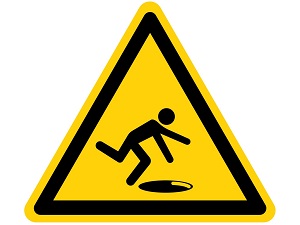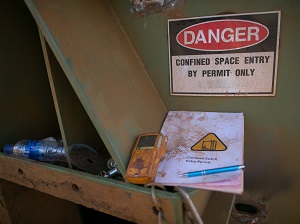Safe grease trap design, training, and maintenance, as part of an overall workplace safety and health program, can prevent grease trap‑related incidents.

Many businesses use grease traps, also known as grease interceptors, as part of a waste management system to prevent sewer system blockages from accumulated waste fats, oils, and greases. Grease traps capture and separate the fats, oils, and greases from wastewater before the water flows to the local sewer system.
In smaller kitchens, these traps might be inside, located near the dishwasher or main sink, and for bigger establishments, they are often outside, close to the building. Because these are typically underground tanks, people can be injured if they trip or fall into a grease trap that is not properly covered. In some cases, grease traps may also be permit-required confined spaces and can present life-threatening hazards if entered into without safeguards in place.
OSHA Standard 1910.22(d)(1) The employer must ensure walking-working surfaces are inspected, regularly and as necessary, and maintained in a safe condition.
Regardless of where the grease trap is located, it must not present any slip, trip, and fall hazards.

To prevent hazards and potential injuries, grease traps must be properly covered at all times, and those covers must be adequately secured. Covers that are designed for residential use should not be used for commercial purposes.
Large capacity grease traps are often located in outside areas accessible to and frequented by workers. The grease trap is usually located in the ground, with a large manhole-type cover that must remain secure to prevent unauthorized access to the trap and prevent additional waste from entering the trap.
OSHA Standard 1910.29(e) The employer must ensure each cover for a hole in a walking-working surface is capable of supporting without failure, at least twice the maximum intended load that may be imposed on the cover at any one time and is secured to prevent accidental displacement.
Employees working near or around grease traps may be exposed to trip and fall hazards if grease trap covers are not strong enough to support loads placed on them or are not properly secured.
OSHA Standard 1910.28(b)(3) The employer must ensure that each employee is protected from tripping into, stepping into, or falling through any hole.
Workers can trip over an unsecured lid or fall into the large grease and wastewater pit. Workers who fall into a grease trap could suffer serious injuries or may even drown.

When grease traps are large enough for bodily entry, they may be considered permit-required confined spaces, and if so, employers must 1) inform exposed workers of the hazards of the space, 2) post danger signs, and 3) prevent unauthorized entry into the space.
Grease traps can generate flammable and toxic gases over time. These gases can include methane (natural gas), hydrogen sulfide, carbon monoxide, carbon dioxide, and/or other gases depending on the greases, oils, and fats found in the grease traps. Grease traps must be tested and monitored before entry for oxygen content, flammability, toxicity, or explosive hazards.
OSHA Standard 1910.146(c)(5)(ii)(C) Before an employee enters the space, the internal atmosphere shall be tested, with a calibrated direct-reading instrument, for oxygen content, for flammable gases and vapors, and for potential toxic air contaminants, in that order.
Large grease traps are often deep enough to present an engulfment hazard. When traps are deep enough that a worker cannot exit without assistance, a ladder, steps, or another acceptable device should be located in the trap.

.jpg)

